Tyre Pressure Calculator and Monitors
To keep you van stable and tyres from exploding you need to have the right tyre pressures in your van tyres as well as your car tyres. Age of the tyres can also be a factor in spontaneous tyre explosions, I cover that in the Tyre Age post
The easiest way is to simply read the compliance plate on the van, it should have the recommended cold pressure listed on it. Your car should have the pressures listed on a sticker that’s usually on the door jamb or door fame, sometimes the glove box or worst case, read the manual!
Ok, so what to do if you don’t have the info for the van, or the tyres are different to original or the plate doesn’t have the info? All is not lost, you can use the following calculations to get a great starting point.
Firstly have a look at the van tyres and look for the maximum weight and maximum pressure, use the figures for single tyre not dual if it lists both (dual is two tyres side by side, not dual axle).
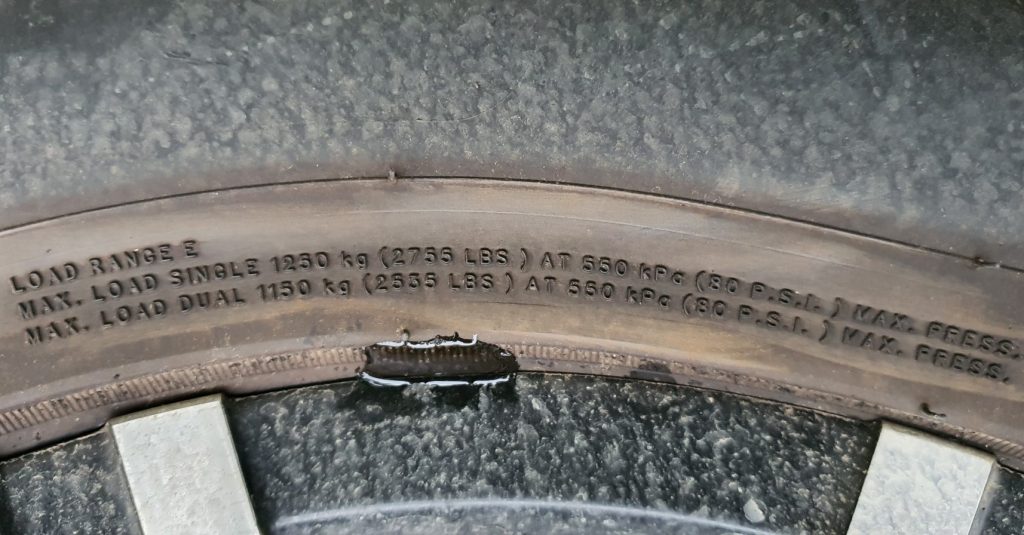
Next you need to know the weight of your van on the wheels, so that’s the Gross Trailer Mass or GTM (or the ATM minus Ball weight). This needs to be the normal operating weight, not the tare, so best to weigh it when fully loaded for your trip. If you are not able to weigh it then work with maximum loads as most vans will be running very close to this anyway.
Now comes the mathematics (or jump ahead to the calculator I built for you!)..
- Divide the GTM by the number of tyres on your van, so we have the weight per tyre.
- Now take the actual weight per tyre just calculated and divide that by the maximum weight listed on the tyre.
- Multiply that answer by the maximum pressure written on the tyre and bingo, there is your cold tyre pressure.
Example:
- Our van has 4 tyres and a GTM of close enough to 3000kg. That’s 3000/4 = 750kg per tyre.
- Our tyres are listed as max 1250kg. So 750 / 1250 = 0.6
- Our tyres are listed as max 80psi. So 0.6 x 80 = 48psi.
Now put away your calculator, I built one for you!
You can also do the same calculation for your car tyres, however you have to remember they will have different loads on them front and rear. That said, most manufacturers only list the same pressure front and rear. This is usually because the load under normal driving is reasonably evenly split. However, when towing this will be a different story. Our vehicle for example when towing is approx 1690kg rear axle and 1240kg front axle, or, 845kg per tyre on the rear and only 620kg per tyre on the front.
So now what, set it and forget? Well you can, this would be generally close enough as long as you check them regularly, however ideally you want to monitor, test and fine tune. There are two common methods here.
First let’s look at the 4 (or 6) PSI rule, which is also known as a 12% rule and based on the pressure in the tyre increasing by approximately 1psi for every 5° increase in temperature (that’s a broad average based on normal pressures around 40PSI). Start with cold tyres, as in sitting still for at least an hour, measure the pressure. Then drive for a good time (an hour is perfect) and measure again. On a P or passenger rated tyre that normally sits around the 30psi mark it will increase approximately 4psi, and on an LT or light truck rated tyre that’s normally around the 50psi mark it will increase by 6psi when inflated to a correct pressure. In both cases this is around 12% increase. If it raises by more, it was too low to start and the tyre is over heating so add some pressure (the flexing of the sidewalls warms the tyre up more). If it only raises a small amount the pressure is too high to start and drop them a little.
Second method is the chalk test and requires no specialised equipment. Get tyres to operating temp, scrub a line of chalk across the tyre then drive in a straight line for around 50m. Now check the chalk – has it rubbed off the edges more than the middle? Too low, pump it up a bit. Has it rubbed off more in the middle? To high, let some air out. has it worn evenly across the tread? Perfect!
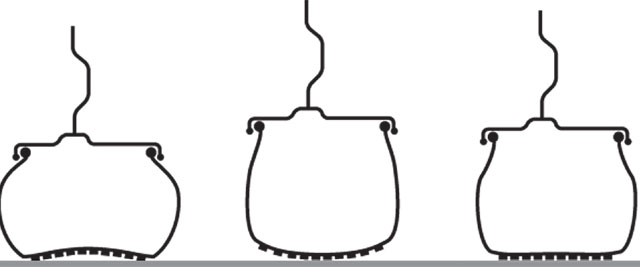
Left = to low and edge chalk wears, middle = too high and centre chalk wears, right = OK and wear is even across the tyre
How do you monitor them?
On the Jeep its pretty easy, it comes with TPMS or Tyre Pressure Monitoring System inbuilt. However the Caravan does not so I have installed one so I can keep an eye on them. Last thing I want is to run over a nail or screw in the middle of nowhere then not realise the tyre is deflating, overheating then shredding itself, potentially creating a sway event that rolls the caravan.
So what to use? First one I bought looked great and seemed to work great too, it was from ODB2 Australia and had a windscreen mounted solar charged display. The only issue I found was the range wasn’t good enough and the display would loose connection with the tyre senders after a while of driving in a straight line (highway driving). After discussions I ordered a repeater, then over the next 9 months received a replacement repeater then two full replacement kits. None of them made any difference. After much testing (Dave the Geek at work) I was able to prove the repeater was connecting to the wheel senders but not to the display and the display was only seeing the senders directly. A year after purchase I was asked to return it for a refund (3 months and 4 emails after it was sent back, radio silence… as in no refund and no reply to the emails – yes I could call and probably will next, I just prefer things to be in writing). Update mid 2023 (a year after returned) – still no contact, they have blocked me from all socials and refuse to answer or acknowledge emails (no phone number). I have raised a case with WA Consumer Dept and they are investigating. I have been contacted by several other buyers over the last 6 months that have had exactly the same issue with these guys.
The below picture is showing the right side tyres missing off the display, left disappeared a few minutes later (an hour of driving with no signal from the tyre and that tyre indicator goes blank). This was a real shame as the unit was small and unobtrusive. (online group discussions appear to show there was an issue with firmware versions of the display not being compatible with the repeater).
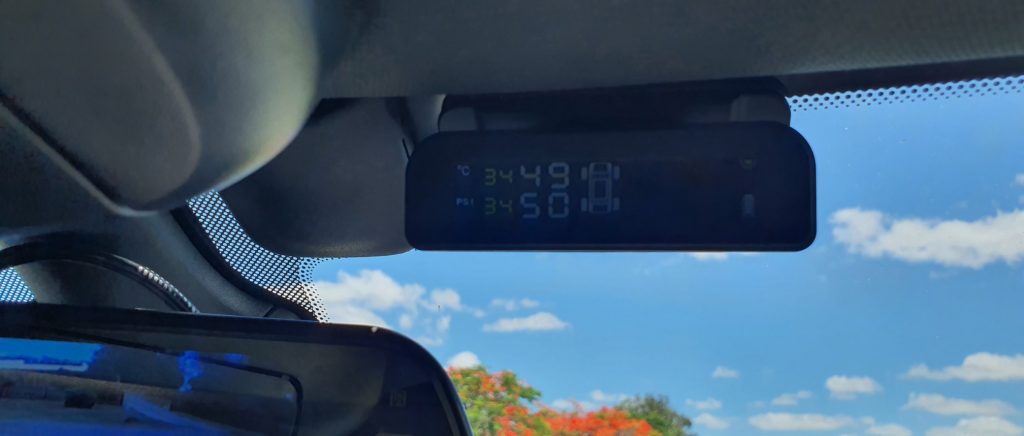
I now have the Safety Dave TPMS system at 4 times the price, the display is larger and bit more cumbersome to mount and does not have a solar charger so has to be plugged into USB every few weeks, but instead of a 8 to 10 m range it reportedly has a 200m range. First long drive coming up in a few days where I will be able to check out how it works. It was purchased from Everything Caravans – an online store in Victoria. Great service and prices, highly recommend them.
Update 6th June 2022: Nice long drive from Melbourne to Adelaide and same issue. Driving in a straight line the sensors drop off the display after about 45 minutes. Chat with Safety Dave help line and we re-programmed the link and parameters as they said this is usually the problem. Next drive was Adelaide to Port Augusta – same issue. Called them again and was asked it this was with the booster running.. I replied the what?? Anyway, it has now been sent back and a replacement will be sent soon with a booster apparently. Will see how this one works!
Update 4th July 2022: booster received in Coober Pedy and installed, now a thousand or so km later of towing it hasn’t missed a beat. So yes, the booster solved my issues. It came with a cigarette lighter adaptor attached and I have an outside TV cabinet on the van with a cigarette socket in it, so have just left it in there for now. I do also have a 12v ignition wire in behind the fridge that is unused so I may connect it up to that for the long term so I don’t need to remember to turn it on and off. It will then only run when the car is connected and running.
Update 17 May 2023. The battery on the monitor appeared to have died after being let sit for 4 weeks (not plugged in) while we stayed in one location. A quick email to Safety Dave, sent the monitor back and they tested to confirm then express posted a replacement pre programmed with all settings (except the sensors being linked of course) and a new charger in case the original one was not working correctly. Love these guys – Perhaps the team at OBDII could take note…
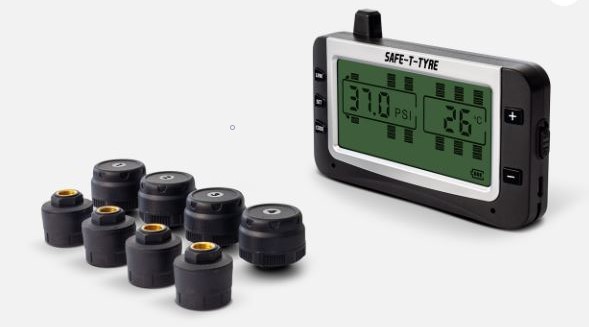
Hope that helps!


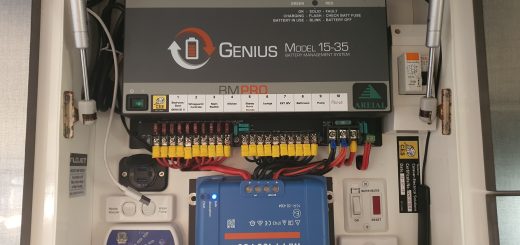
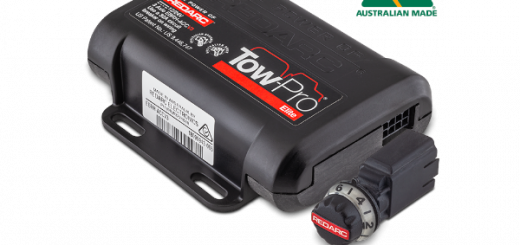

Recent Comments